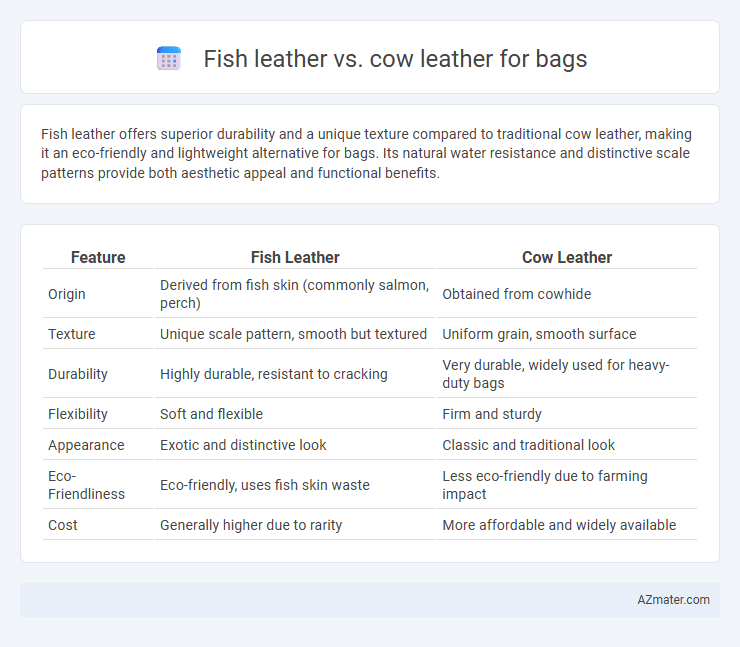Fish leather offers superior durability and a unique texture compared to traditional cow leather, making it an eco-friendly and lightweight alternative for bags. Its natural water resistance and distinctive scale patterns provide both aesthetic appeal and functional benefits.
Table of Comparison
| Feature | Fish Leather | Cow Leather |
|---|---|---|
| Origin | Derived from fish skin (commonly salmon, perch) | Obtained from cowhide |
| Texture | Unique scale pattern, smooth but textured | Uniform grain, smooth surface |
| Durability | Highly durable, resistant to cracking | Very durable, widely used for heavy-duty bags |
| Flexibility | Soft and flexible | Firm and sturdy |
| Appearance | Exotic and distinctive look | Classic and traditional look |
| Eco-Friendliness | Eco-friendly, uses fish skin waste | Less eco-friendly due to farming impact |
| Cost | Generally higher due to rarity | More affordable and widely available |
Introduction to Fish Leather and Cow Leather
Fish leather, derived primarily from species such as salmon, cod, and perch, offers a unique texture and increased durability compared to traditional cow leather, making it an innovative material choice for bags. Cow leather, harvested from cattle, remains the most widely used material in the leather industry due to its strength, elasticity, and ability to be treated for various finishes. Both materials present distinct environmental impacts and aesthetic qualities, with fish leather being more sustainable and lightweight, while cow leather is known for its classic appearance and robustness.
Sourcing: Fish Leather vs Cow Leather
Fish leather is sourced from byproducts of the fishing industry, utilizing skins from species like salmon, perch, and cod, making it a sustainable and eco-friendly alternative. Cow leather comes from cattle hides, which require significant land, water, and feed resources, contributing to larger environmental footprints. Fish leather's sourcing minimizes waste and supports circular fashion, while cow leather relies on resource-intensive livestock farming.
Sustainability and Environmental Impact
Fish leather offers a sustainable alternative to cow leather by utilizing byproducts from the fishing industry, reducing waste and minimizing the need for additional animal farming. Its production consumes less water and generates fewer greenhouse gases compared to traditional cow leather tanning, significantly lowering environmental impact. Fish leather is biodegradable and often uses natural tanning methods, contributing to eco-friendly fashion and responsible material sourcing for bags.
Physical Properties and Durability
Fish leather offers a unique combination of lightweight texture and high tensile strength, making it highly durable despite its thinness compared to cow leather. Cow leather, known for its robust and thick grain structure, provides excellent abrasion resistance and long-lasting toughness suitable for heavy use. Both materials show water resistance, but fish leather's natural scales offer added flexibility and a distinctive pattern, enhancing aesthetic appeal for bags while maintaining durability.
Texture and Appearance Comparison
Fish leather offers a unique texture characterized by its natural scale patterns and flexible yet durable surface, providing a distinctive, exotic look that stands out compared to cow leather. Cow leather features a smoother, more uniform grain with a classic appearance often associated with luxury and robustness in bag design. While fish leather tends to have a shinier, more reflective finish, cow leather generally delivers a matte or semi-glossy surface that ages with a rich patina over time.
Versatility and Design Options
Fish leather offers superior versatility in design due to its unique textures and natural scale patterns, allowing for more intricate and visually striking bag styles compared to cow leather. The durable yet flexible nature of fish leather supports a wide range of shapes and innovative finishes, making it ideal for fashion-forward, artisanal bags. Cow leather remains popular for classic and consistent textures but lacks the distinctive, customizable aesthetic potential that fish leather provides in modern bag design.
Processing and Tanning Methods
Fish leather undergoes specialized tanning using natural oils and enzymes to preserve its unique scale patterns and flexibility, making it more sustainable and eco-friendly compared to conventional methods. Cow leather typically involves chrome tanning, a faster process that enhances durability but relies on heavy metals and chemicals, impacting environmental health. The artisanal processing of fish leather demands gentler handling to maintain its thin structure, contrasting with the more robust preparation needed for thicker cowhide used in bags.
Cost and Market Value
Fish leather offers a unique, eco-friendly alternative to traditional cow leather, often costing 20-30% more due to its rarity and labor-intensive processing. Cow leather dominates the market with consistent pricing and widespread availability, making it more affordable for mass-produced bags. Market value for fish leather bags is higher in niche luxury segments, attracting eco-conscious consumers willing to pay a premium for sustainability and distinctive texture.
Maintenance and Longevity
Fish leather, known for its unique texture and water resistance, requires minimal maintenance, often needing only occasional cleaning with a damp cloth to preserve its durability. Cow leather, though more traditional, demands regular conditioning and protection from moisture to prevent cracking and extend the bag's lifespan. Fish leather bags generally offer superior longevity in humid conditions due to their natural resilience, while cow leather bags excel in durability with proper care over time.
Choosing the Right Leather for Your Bag
Fish leather offers a unique texture and higher durability compared to cow leather, making it an excellent choice for stylish, long-lasting bags. Cow leather is widely preferred for its classic look, flexibility, and availability, suited for traditional and versatile bag designs. When choosing the right leather for your bag, consider factors such as durability, texture, environmental impact, and style preference to ensure the material aligns with your personal needs and fashion sense.

Infographic: Fish leather vs Cow leather for Bag
 azmater.com
azmater.com